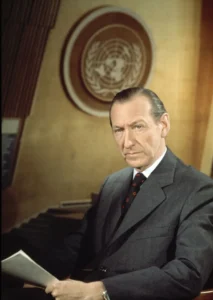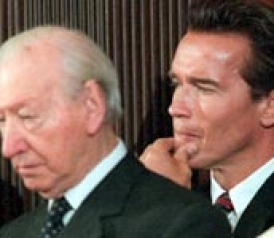Nazi at the UN: Kurt Waldheim
By The Telegraph, June 18, 2007

Kurt Waldheim
Kurt Waldheim was Secretary-General of the United Nations for 10 years; later he was elected President of Austria, even though details of his wartime participation in the barbarous Nazi occupation of the Balkans emerged during his campaign.
In the process Waldheim became the best-known Austrian politician since Adolf Hitler, and his election and subsequent period of office precipitated Austria’s most serious moral and political crisis since 1945.
Despite the fact that he wrote an autobiography, Waldheim’s life before he entered the Austrian foreign ministry in 1945 remains difficult to reconstruct, not least because of his own dissembling.
One of his laconic accounts of the war went thus: “I was wounded on the Eastern Front, was no longer fit for front-line service and completed my legal studies in Vienna, where I received my doctorate in 1944.”
What actually took place after 1941 was first reliably reconstructed in the report of the Historians’ Commission appointed by the Austrian government to investigate his past.
Kurt Josef Waldheim was born on December 21 1918 at Tulln, near Vienna. Shortly before his birth the Habsburg monarchy had collapsed, and his father, whose Czech family had been called Watzlawick, decided to change his name.
Kurt’s father, the district school inspector, educated his son to be Roman Catholic, conservative and loyal to the precarious but authoritarian First Republic. After the Anschluss with Nazi Germany in March 1938, however, he lost his job.
The young Waldheim read Law at Vienna University and attended the Consular Academy for future diplomats. In 1938 he joined the Nazi student association and a Brownshirt riding club, the SA-Reiterstandarte 5/90.
He displayed opportunism by joining these organisations, but not necessarily Nazi convictions. His fiancée Elisabeth, however, whom he married in 1944, was a Nazi party member and she probably influenced him.
At the outbreak of war Waldheim was conscripted into a cavalry regiment, but he first saw action in Russia in 1941. He was decorated and wounded and became familiar with the Wehrmacht’s methods of crushing partisan opposition. His subsequent military career remained unknown to all but a handful of people until 1986.
In March 1942 Waldheim, by now a lieutenant with fluent Italian, French and English, was sent to the headquarters of the Twelfth Army in Pjlevlja, Yugoslavia.
In his capacity as an intelligence officer linking German and Italian forces, he immediately encountered the full harshness of the Germans and their Croatian allies during the offensives in east Bosnia and, from June 1942, in west Bosnia.
Waldheim was probably not involved in the handing over of 488 prisoners to be shot by the SS in May 1942, as was later alleged. But he was fully initiated in the frightful massacres and deportations in the vicinity of Kozara during the summer of 1942.
He returned from four months’ leave in March 1943 as a member of the staff of the Austrian General Alexander Lohr, chief of the newly-formed Army Group E, based at Arsakli, a suburb overlooking Salonika.

Arnold Schwarzenegger openly supported Kurt Waldheim, former UN chief and a former Austrian politician who participated in Nazi atrocities during World War II. Schwarzenegger’s name remained on Waldheim’s campaign posters, even after allegations of Waldheim’s war crimes were brought to light. Waldheim was even invited to Arnold’s wedding. – Arnoldexposed.com –

